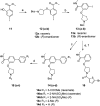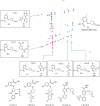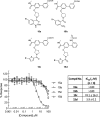Discovery, SAR, and X-ray Binding Mode Study of BCATm Inhibitors from a Novel DNA-Encoded Library
- PMID: 26288694
- PMCID: PMC4538436
- DOI: 10.1021/acsmedchemlett.5b00179
Discovery, SAR, and X-ray Binding Mode Study of BCATm Inhibitors from a Novel DNA-Encoded Library
Abstract
As a potential target for obesity, human BCATm was screened against more than 14 billion DNA encoded compounds of distinct scaffolds followed by off-DNA synthesis and activity confirmation. As a consequence, several series of BCATm inhibitors were discovered. One representative compound (R)-3-((1-(5-bromothiophene-2-carbonyl)pyrrolidin-3-yl)oxy)-N-methyl-2'-(methylsulfonamido)-[1,1'-biphenyl]-4-carboxamide (15e) from a novel compound library synthesized via on-DNA Suzuki-Miyaura cross-coupling showed BCATm inhibitory activity with IC50 = 2.0 μM. A protein crystal structure of 15e revealed that it binds to BCATm within the catalytic site adjacent to the PLP cofactor. The identification of this novel inhibitor series plus the establishment of a BCATm protein structure provided a good starting point for future structure-based discovery of BCATm inhibitors.
Keywords: BCATm; DNA Encoded Library; ELT; obesity; on-DNA Suzuki−Miyaura cross-coupling reaction.
Conflict of interest statement
The authors declare no competing financial interest.
Figures






References
-
- Kimball S. R.; Jefferson L. S. Signaling Pathways and Molecular Mechanisms through which BCAA Mediate Translational Control of Protein Synthesis. J. Nutr. 2006, 136, 227S–231S. - PubMed
-
- Tischler M. E.; Desautels M.; Goldberg A. L. Does Leucine, Leucyl-tRNA, or Some Metabolite of Leucine Regulate Protein Synthesis and Degradation in Skeletal and Cardiac Muscle?. J. Biol. Chem. 1982, 257, 1613–1621. - PubMed
LinkOut - more resources
Full Text Sources
Other Literature Sources
Research Materials
Miscellaneous

